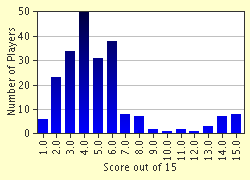Quiz Answer Key and Fun Facts
1. Beginning in the fifth millennium BCE, this was the first 'civilisation' in China. Named after a village in Henan province where signs of an ancient settlement were found, this culture created ceramics, domesticated animals and had fairly advanced agricultural practices. Which civilisation is being referred to?
2. This Egyptian pharaoh was of the 4th dynasty of Egypt's Old Kingdom. He is most famous for building the great pyramids of Giza, that stand to this day. Who is he?
3. At its height the Han Empire's population was close to which of the following figures?
4. This Chinese warlord is one of the most dominant and famous figures in Chinese history. His exploits are detailed in the famous novel, 'Romance of the Three Kingdoms', and he ruled over the Kingdom of Wei following the collapse of the Han Empire. He was posthumously titled Emperor Wu. Who is being referred to?
5. Which famous Buddhist monk travelled to India in the early 7th century after the fall of the Sui Empire?
6. Which southern Indian empire is famous principally for its art and architecture (examples of which can be found at Belur and Halebid)? This empire existed between 1000 CE and 1346 CE.
7. In which year did the city of Jerusalem fall to the army of Salah ad-Din?
8. In 1274 Kubilai Khan, the Great Khan of the Mongol Empire, ruler of half of Eurasia, launched an invasion of Japan. The invasion failed after just one battle against the Japanese on Kyushu. Where did this battle take place?
9. Although offered the title of Emperor, this man never accepted, preferring to stay behind the throne of the Mexica (Aztec) Empire. Born in 1397 and dying in 1487 he was a ruthless conqueror and he led the conquests of a number of neighbouring states, raising his nation to the height of power in Mexico. He was the nephew of Emperor Itzcˇatl and brother of Emperor Moctezuma I. Who is being referred to?
10. In the siege of Odawara, Toyotomi Hideyoshi confronted which clan?
11. On which date did the Great French War (or more specifically the War of the First Coalition or the French Revolutionary War) begin?
12. Each of the following events occurred on 2 December. The coronation of NapolÚon I, the Battle of Austerlitz, Illinois becomes the twenty-first US state, the overthrow of the Second French Republic, the coronation of NapolÚon III, Fidel Castro declares that Cuba is to be a communist state, the United Arab Emirates are formed, Gough Whitlam becomes the first ALP prime minister of Australia in more than two decades and the Lao People's Democratic Republic is established.
13. What was the given name of the Qianlong Emperor of the Qing dynasty?
14. Which were the only two African states to remain outside European control for the entire duration of the nineteenth century?
15. Soviet and Chinese forces fought on this river in 1969. Which river is this?
Source: Author
Findlay
This quiz was reviewed by FunTrivia editor
bloomsby before going online.
Any errors found in FunTrivia content are routinely corrected through our feedback system.


